For me, getting out into nature to enjoy a hike with my dogs is one of the most relaxing, fulfilling activities we can do together.
But adventuring out in the wild with my small dogs means that we may be faced with potential threats.
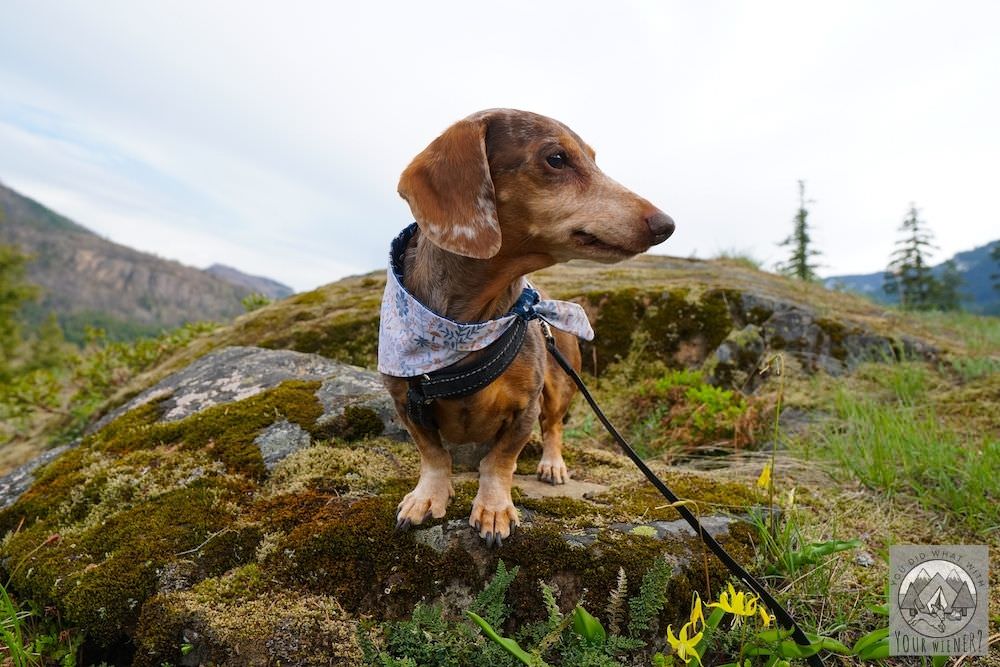


Each time we venture out into the woods, we are intruding on the habitat of the wildlife that lives there.
I’ve done a lot of research over the years so I can keep my dogs safe if we do get into a confrontation with a wild animal.
In this article, I’m sharing what I have learned with you.
Note: wildlife can vary slightly by region so it’s imperative you understand what type of wildlife is in your surrounding hiking areas, and how to handle it if you and your pup come across a dangerous situation.
What Type of Wildlife is Typically Encountered While Hiking?
Small dog owners have heard plenty of horror stories about tiny pets being snatched up by wild animals.
Whether it happens while camping or hiking, each scenario would be equally terrifying.
The type of wildlife that you and your pup will come across while hiking is going to differ depending on where you’re located.
The wildlife you might encounter varies depending on what terrain and location you’re hiking on.
Also, it will depend on what kind of landscape you are hiking in. For example, if you’re hiking in the desert the risks are different than being in a more temperate climate.
Below are some common wildlife yepes that you may encounter while hiking with your small dog, as well as the risks of each.
I also talk about what to do if you come face to face with a threatening creature.
Cougars and Bobcats
Bobcats (and many other large, wild cats) are bold predators. They’ve been known to go after small pets and livestock as prey.
These big animals can pose a major threat to both us and our small dogs.
If you happen to encounter one, quickly pick up your dog and slowly walk away. Running could cause the cat to chase you out of instinct.
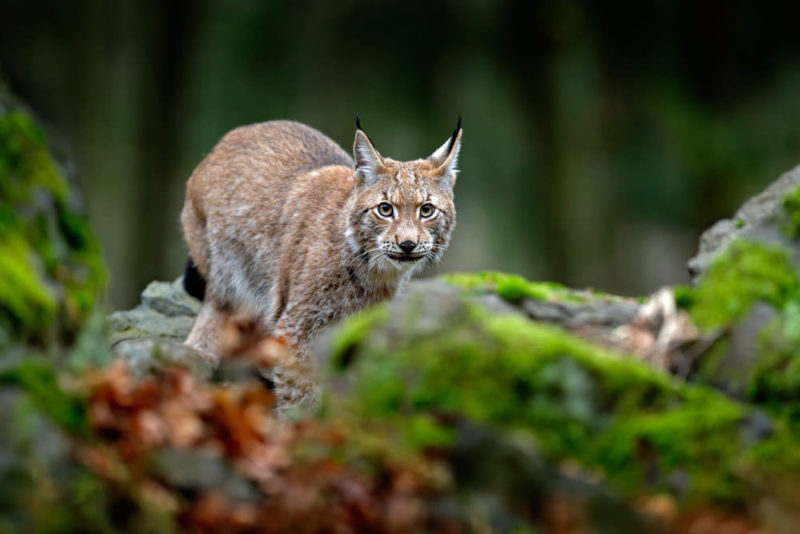


Your main defenses against a cougar are:
- Make a lot of noise, such as banging on something, to try frighten the animal
- Try to make yourself look as big as possible so, hopefully, the cougar will see you as a threat, not prey
Once the bobcat flees, leave the area and get somewhere safe.
For more information, read this list of seven things to do if you encounter a big cat.
Mountain goats
Mountain goats may seem cute and less frightening than other predatory creatures on our list. However, they can be quite aggressive.
A mountain goat killed a hiker in Olympic National Park in 2017. This was a rare tragedy but, unfortunately, coat-hiker confrontations do happen.
Mountain goats don’t have the same “flight” response as many other animals. They don’t fear humans like other wildlife and, in fact, crave the salt in sweat and urine so may approach a source (you or your dog).
While they may look harmless, mountain goats are an animal you’ll want to back away from.
Your best course of action if you encounter a mountain goat with your dog to simply back away.
If the goat starts to approach you, it can get tricky as the best defense can vary by season.
In summer, if a goat starts to approach you in a determined and aggressive way, stand your ground and try to shoo the goat away.
However, in fall, especially if it’s a male goat, you should NOT challenge it. It may be looking for a mate and see you as a competitor if you suddenly become threatening.
Bears
There are two types of bears you are most likely to encounter, depending on where you are hiking – a Grizzly Bear or the more docile Black Bear.
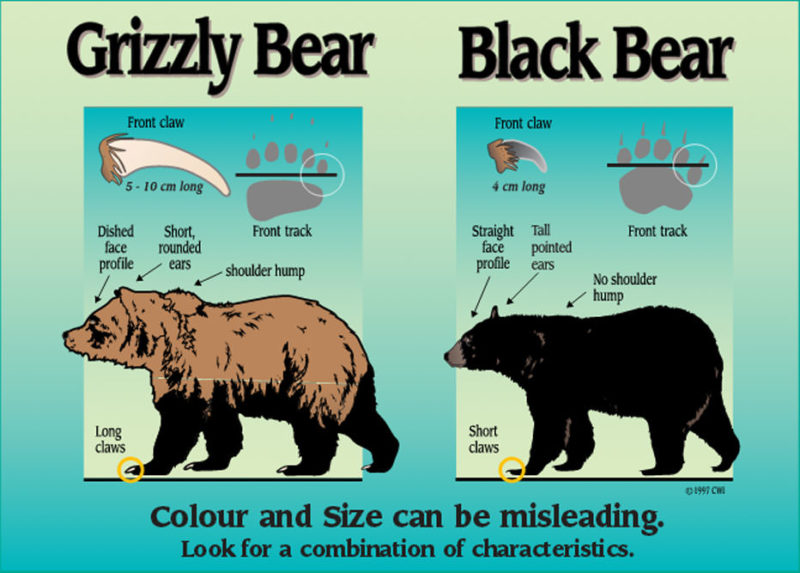


When trying to tell these bars apart, what is confusing is that Black Bears can often be brown like a Grizzly. But there are some distinct differences.
The Grizzly bear has a pronounced shoulder hump, a concave or “dished” facial profile, smaller ears and much larger claws than the black bear.
Black bears have a flatter, “Roman-nose” profile, larger ears, no visible shoulder hump and smaller claws.
For more information, check out on BearSmart.com (the source of the graphic above).
In almost all cases, bear attacks occur when bears are surprised at close range, are eating a carcass, or are protecting their young.
Your best defense is to try never to startle one or interfere with their food or babies.
Black Bears
In Washington State where we live, this is the most common type of bear we see.
Black bears aren’t always black. They may aslo be brown if their fur has been bleached from the sun.
While there have been Grizzly Bear sightings in the northern portions of North Cascades National Park, and in the Selkirk Mountains in the far northeast corner of the state, they are very rare.
Despite the name, a Black Bear is not always black in color. They may appear brown like a Grizzly bear.
They can be differentiated from a Grizzly Bear because they have no shoulder hump, pointed ears, and the bridge of their nose is straight.
For a more on the differences between Black and Grizzly bears, click here.
This is the only kind of bear I’ve encountered in person and only one of those times was with a dog from a distance.
I will say though that I am not scared of Black Bears. Black Bear attacks are very rare.
They are primarily herbivores and would much rather keep munching on ripe berries than me or my dog.
No one wants to have a tense encounter with a bear bear. Luckily, Black Bears will likely ignore you or walk away.
If I was to see a Black Bear, this would be my first action steps:
- Pick up my small dog(s) so they can’t pull at the end of the leash toward the bear and, hopefully, don’t bark at it
- Look behind me to make sure there is not a bear cub standing behind me. That’s is the #1 thing that makes Black Bears mad – if someone gets in between them and their cubs.
- Move along the trail calmly and immediately but slowly as to not draw attention
If, for some reason, the bear took too much interest in us for my liking, I would look it in the eye and try to scare it away.
This should NEVER be done with a Grizzly Bear but there is a good chance a Black Bear would determine you are not worth their time or hassle and move on.
Grizzly Bears
Although Grizzlies are omnivores, they will feast on large and small animals when given the opportunity.
Grizzly Bears are more worrisome for dogs and people for this reason.
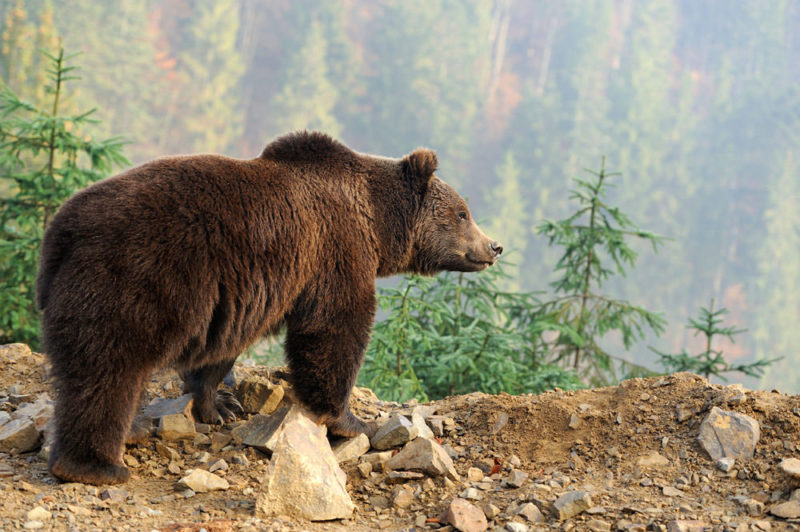


If you and your dog come into contact with a Grizzly Bear, avoid eye contact and DO NOT run away.
If the bear is keeping its distance, very slowly remove yourself from the situation. Do not scream or yell. Simply wave your hands at the bear, and speak in a monotone.
If your dog is barking, do your best to control it and refocus their attention while walking away.
If the bear charges you, you cannot outrun it. Instead, stand your ground.
Your first line of defense should be using your bear spray/repellent as a deterrent (it’s a good idea to practice using it at least once before you need to use it on the trail in an emergency situation).
If the bear does make physical contact with you, your first priority will be to try and minimize any physical damage the bear can do to you.
Lay flat on the ground, or curl up in a ball, and try to cover the back of your neck and head with your hands. Attempt to remain as quiet as possible.
This is usually referred to as “playing dead” so the bear will lose interest in you or think they have taken care of any threat.
If you think also protecting your dog while protecting yourself is possible, you can try laying on top of them.
As much as you love your dog, remember that your first priority should be to save your own life.
Real talk: if the situation escalates to this magnitude, your priority should be saving your own life, which means you may need to leave your dog to defend themselves.
Predatory birds
Eagles, hawks and other aggressive birds can pose a threat to your small dog.
Always stay away from a nesting area, as these birds will do anything to protect their young.
Normally hawks and other birds become most angered if you get near their nest, so it’s best to move away out of the area at all costs.
Aggressive hawks can swoop down and attack or attempt to snatch up your dog if your back is turned.
It’s recommended that you face the hawk should you encounter one.
Rattlesnakes
Rattlesnake bites can be harmful to both humans and dogs. They are incredibly dangerous, and shouldn’t be underestimated.
Rattlesnakes would rather avoid humans, but they will strike when threatened or accidentally stepped on.
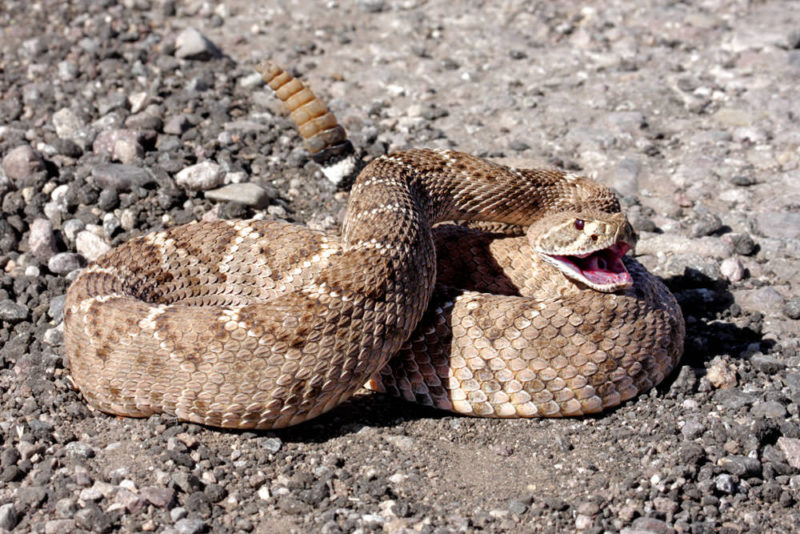


If you spot a rattlesnake near you, stop and freeze. Cease all movement and assess the situation. Then slowly back off.
Snakes like to hide out in brush, so stay on hiking trails with your pup in rattlesnake country.
Dogs are more likely than humans to be bitten by rattlesnakes, so we suggest picking up your dog and walking away from the snake if you can.
Also, there are workshops that teach humans and their pups what to do if you encounter a poisonous snake.
Skunk
Skunks aren’t necessarily dangerous, but you’ll have a heck of a time getting the smell out of your dog’s coat if they get sprayed.
Skunks are nocturnal, so you’re more likely to encounter them on nighttime hikes.
If you see a skunk, walk the other way and leave it alone. It won’t spray unless threatened.
Keep your dog on a fixed lead and move in a different direction.
Porcupine
Porcupines are large rodents outfitted with large quills to protect themselves.
While porcupines can’t shoot their quills from far away, the quills detach easily and can stick in your dog by merely brushing up against them.
Like skunks, porcupines are nocturnal, so you probably won’t see one on a midday hike. They are also scared of humans, and will keep their distance.
Although porcupines cannot shoot their quills at you from a distance, they are dangerous little creatures. If your dog gets too close, porcupine quills can get stuck in their face and mouth.
Should a quill become lodged in your dog’s skin or your own, it can be extremely painful to remove and infection is likely.
If you and your small dog see a porcupine, move away slowly. The rodent wants to escape as much as you do so try not to surprise them.
Javelina
Javelinas, also known as collared peccary, can be nasty animals. They enjoy romping through the desert and terrorizing prey.
Small dogs and cats often fall victim to a javelina’s appetite, as they quickly become vicious and aggressive.
Javelina also move in packs, so if you see one, just know that there are several others lurking about.
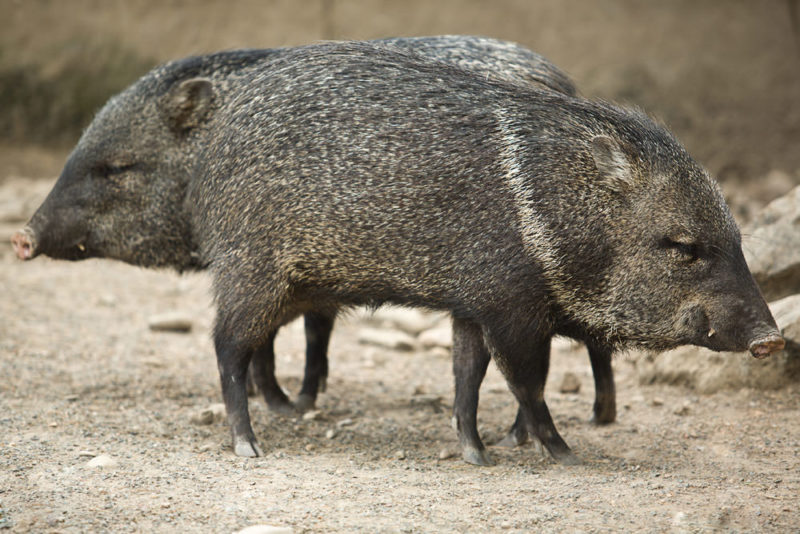


When you come across these wild boar-like animals, make lots of noise such as stomping, clapping or yelling.
Don’t corner the javelina – instead walk away slowly and give it a chance to run away.
Coyotes
Coyotes are probably the most common animal on this list that you might also encounter in an urban area.
Fortunately, coyotes are actually fairly tame animals who want to avoid you as much as you want to avoid them.
You and your dog should still avoid them as much as possible though.
Do not run or turn your back to a coyote, as that can be seen as a sign of weakness. Just pick up your dog, and make it appear that you’re the bigger threat.
The coyote is likely to back away, because they truly want nothing to do with you.
General Wildlife Safety Tips for You and Your Dog
Ultimately practicing caution and common sense when hiking with your small dog is the best way to stay safe.
Staying in control of your dog, and knowing what to do during an encounter, is the best way to keep your small dog safe from wildlife.
Use the tips below as general safety guidelines.
1. Always maintain control of your dog: While hiking, keep your small dog on a fixed leash and harness so you have control at all times. Retractable leashes or allowing your pup to be off leash in a wildlife scenario is a disaster waiting to happen.
2. Carry pepper or bear spray: Pepper spray can be used on wild animals should you encounter a desperate situation.
3. Stay on trails: You are less likely to spot predatory animals while hiking if you stay on designated trails.
4. Do not let your dog harass wildlife: It can be hard for pups to leave other animals alone, but it’s best to ensure that your dog is not aggravating animals in their natural habitats. Allowing your dog to approach unknown animals will not end well.
Conclusion
While hiking with your small dog is incredibly rewarding and fun, it’s best to be prepared for anything nature might throw at you.
As long as you understand how to appropriately deal with wild animals and you take adequate safety precautions, you and your dog will be safe.
Keep your furry companion on a leash, be aware of your surroundings, stay on trails and enjoy the scenery, and know what to do if you come face-to-face with wildlife.
<!–
–>
source http://www.luckydogsolutions.com/how-to-protect-your-small-dog-from-wildlife-while-hiking/

No comments:
Post a Comment